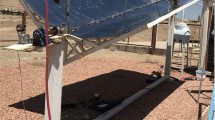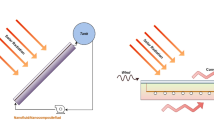Abstract
Solar Water Heating system ascertains to be potential technology that effectively converts solar energy to thermal energy. Utilizing nanofluid is one conventional method to ameliorate the heat performance of solar water heating system. This paper aims at presenting the energy and exergy analysis of solar water heating system with Compound Parabolic Collector using Cobalt Oxide (Co3O4)/Distilled Water nanofluid. The volume concentration is considered as 0.2% and 0.4%. The experiment is conducted in different mass flow rates ranging from 0.5 kg/min to 2.5 kg/min with an interval of 0.5 kg/min. Cetyl Trimethyl Ammonium Bromide is used as the surfactant to prevent the sedimentation of the nanoparticle. Thermal conductivity of the nanofluid enhanced up to 24.35% for 0.4 vol% at 70 ˚C compared to Distilled Water. Though the inclusion of surfactant improved the stability of the nanoparticle in the base fluid, it generated an adverse effect on the thermo-physical property of the nanofluid. Thermal conductivity of the nanofluid with surfactant reduced by 10% while the viscosity increased by 1.1 times compared to nanofluid without surfactant. The outlet temperature of the working fluid improved by 10% and 5.5% while using nanofluid of 0.2 vol% and it further improved by 21.5% and 10.62% while using nanofluid of 0.4 vol% compared to using distilled water as working fluid at the lowest and highest flow rate respectively. Maximum enhancement in energy rate of about 33.32% and 40.88% is observed at the highest flow rate for nanofluid with 0.2 vol% and 0.4 vol%. The exergy efficiency of the system surged up to 20.87% while using nanofluid with 0.4 vol% at the lowest mass flow rate. Exergy destruction of the system reduced by 9.1% and 13.75% at the highest flow rate while using nanofluid of 0.4 vol%. The exergy loss of the system decreased with an improved volume concentration of the nanofluid.












Similar content being viewed by others
Abbreviations
- Ac :
-
Area of the Collector, m2
- To :
-
Outlet Temperature, ˚C
- Ti :
-
Inlet Temperature, ˚C
- m:
-
Mass Flow Rate, kg/min
- Cp :
-
Specific Heat Capacity, J/kgK
- H:
-
Height of CPC, mm
- Wd:
-
Width of CPC, mm
- I:
-
Solar Radiation, W
- Pi :
-
Pressure at the inlet, Pa
- Po :
-
Pressure at the outlet, Pa
- Ėx:
-
Exergy Rate, W
- Ta :
-
Ambient Temperature, K
- Ts :
-
Sun Temperature, K
- h:
-
Specific Enthalpy, J/kg
- Sgen :
-
Entropy Generation, W
- kp:
-
Thermal Conductivity, W/mK
- W:
-
Weight, kg
- At :
-
Surface area of the tube, mm2
- Tt:
-
Tube temperature, K
- U1:
-
Heat Loss Coefficient
- η:
-
Energy Efficiency
- ηex:
-
Exergy Efficiency
- ρ:
-
Density, kg/m3
- ∅:
-
Volume Concentration (vol %)
- τ:
-
Transmittance Coefficient
- α:
-
Absorptance of glazing
- Φ:
-
Diameter, mm
- θa :
-
Acceptance Angle (degree)
- θ:
-
Diffraction angle (degree)
- λ:
-
Wavelength of XRD (Å)
- β:
-
Breadth angle
- SWH:
-
Solar Water Heater
- CPC:
-
Compound Parabolic Collector
- DW:
-
Distilled Water
- NF:
-
Nanofluid
- CTAB:
-
Cetyl Trimethyl Ammonium Bromide
- SWCNT:
-
Single Wall Carbon Nano Tube
- MWCNT:
-
Multi-Wall Carbon Nano Tube
- TC:
-
Thermal Conductivity
References
Pranesh V, Velraj R, Christopher S, Kumaresan V (2019) A 50 year review of basic and applied research in compound parabolic concentrating solar thermal collector for domestic and industrial applications. Sol Energy 187:293–340. https://doi.org/10.1016/j.solener.2019.04.056
Choi SUS, Eastman JA (1995) Enhancing thermal conductivity of fluids with nanoparticles. ASME Int Mech Eng Congr Expo 66:99–105. https://doi.org/10.1115/1.1532008
Said Z, Saidur R, Sabiha MA, Rahim NA, Anisur MR (2015) Thermophysical properties of Single Wall Carbon Nanotubes and its effect on exergy efficiency of a flat plate solar collector. Sol Energy 115:757–769. https://doi.org/10.1016/j.solener.2015.02.037
Yousefi T, Veisy F, Shojaeizadeh E, Zinadini S (2012) An experimental investigation on the effect of MWCNT-H2O nanofluid on the efficiency of flat-plate solar collectors. Exp Therm Fluid Sci 39:207–212. https://doi.org/10.1016/j.expthermflusci.2012.01.025
Yousefi T, Shojaeizadeh E, Veysi F, Zinadini S (2012) An experimental investigation on the effect of pH variation of MWCNT–H2O nanofluid on the efficiency of a flat-plate solar collector. Sol Energy 86:771–779. https://doi.org/10.1016/j.solener.2011.12.003
Tiwari A, Dubey S, Sandhu GS, Sodha MS, Anwar SI (2009) Exergy analysis of integrated photovoltaic thermal solar water heater under constant flow rate and constant collection temperature modes. Appl Energy 86:2592–2597. https://doi.org/10.1016/j.apenergy.2009.04.004
Said Z, Saidur R, Rahim NA (2016) Energy and exergy analysis of a flat plate solar collector using different sizes of aluminium oxide based nanofluid. J Clean Prod 133:518–530. https://doi.org/10.1016/j.jclepro.2016.05.178
Colangelo G, Favale E, De Risi A, Laforgia D (2013) A new solution for reduced sedimentation flat panel solar thermal collector using nanofluids. Appl Energy 111:80–93. https://doi.org/10.1016/j.apenergy.2013.04.069
Moghadam AJ, Farzane-Gord M, Sajadi M, Hoseyn-Zadeh M (2014) Effects of CuO/water nanofluid on the efficiency of a flat-plate solar collector. Exp Therm Fluid Sci 58:9–14. https://doi.org/10.1016/j.expthermflusci.2014.06.014
He Q, Zeng S, Wang S (2014) Experimental investigation on the efficiency of flat-plate solar collectors with nanofluids. Appl Therm Eng 88:165–171. https://doi.org/10.1016/j.applthermaleng.2014.09.053
Michael JJ, Iniyan S (2015) Performance of copper oxide/water nanofluid in a flat plate solar water heater under natural and forced circulations. Energy Convers Manag 95:160–169. https://doi.org/10.1016/j.enconman.2015.02.017
Sint NKC, Choudhury IA, Masjuki HH, Aoyama H (2017) Theoretical analysis to determine the efficiency of a CuO-water nanofluid based-flat plate solar collector for domestic solar water heating system in Myanmar. Sol Energy 155:608–619. https://doi.org/10.1016/j.solener.2017.06.055
Zamzamian A, KeyanpourRad M, KianiNeyestani M, Jamal-Abad MT (2014) An experimental study on the effect of Cu-synthesized/EG nanofluid on the efficiency of flat-plate solar collectors. Renew Energy 71:658–664. https://doi.org/10.1016/j.renene.2014.06.003
Chaji H, Ajabshirchi Y, Esmaeilzadeh E, Heris SZ, Hedayatizadeh M, Kahani M (2013) Experimental study on thermal efficiency of flat plate solar collector using tio 2 /water nanofluid. Mod Appl Sci 7:60–69. https://doi.org/10.5539/mas.v7n10p60
Said Z, Sabiha MA, Saidur R, Hepbasli A, Rahim NA, Mekhilef S, Ward TA (2015) Performance enhancement of a Flat Plate Solar collector using Titanium dioxide nanofluid and Polyethylene Glycol dispersant. J Clean Prod 92:343–353. https://doi.org/10.1016/j.jclepro.2015.01.007
Meibodi SS, Kianifar A, Niazmand H, Mahian O, Wongwises S (2015) Experimental investigation on the thermal efficiency and performance characteristics of a flat plate solar collector using SiO2/EG-water nanofluids, Int. Commun. Heat Mass Transf 65 71–75. https://doi.org/10.1016/j.icheatmasstransfer.2015.02.011
Faizal M, Saidur R, Mekhilef S, Alim MA (2013) Energy, economic and environmental analysis of metal oxides nanofluid for flat-plate solar collector. Energy Convers Manag 76:162–168. https://doi.org/10.1016/j.enconman.2013.07.038
Ahmadi A, Ganji DD, Jafarkazemi F (2016) Analysis of utilizing Graphene nanoplatelets to enhance thermal performance of flat plate solar collectors. Energy Convers Manag 126:1–11. https://doi.org/10.1016/j.enconman.2016.07.061
Vincely DA, Natarajan E (2016) Experimental investigation of the solar FPC performance using graphene oxide nanofluid under forced circulation, Energy Convers. Manag. 117 1–11. https://doi.org/10.1016/j.enconman.2016.03.015
Verma SK, Tiwari AK, Chauhan DS (2016) Performance augmentation in flat plate solar collector using MgO/water nanofluid. Energy Convers Manag 124:607–617. https://doi.org/10.1016/j.enconman.2016.07.007
Farajzadeh E, Movahed S, Hosseini R (2018) Experimental and numerical investigations on the effect of Al2O3/TiO2[sbnd]H2O nanofluids on thermal efficiency of the flat plate solar collector. Renew Energy 118:122–130. https://doi.org/10.1016/j.renene.2017.10.102
Gulzar O, Qayoum A, Gupta R (2019) Photo-thermal characteristics of hybrid nanofluids based on Therminol-55 oil for concentrating solar collectors. Appl Nanosci 9:1133–1143. https://doi.org/10.1007/s13204-018-0738-4
Akilu S, Baheta AT, Mior MA, Minea AA, Sharma KV (2018) Properties of glycerol and ethylene glycol mixture based SiO2-CuO/C hybrid nanofluid for enhanced solar energy transport. Sol Energy Mater Sol Cells 179:118–128. https://doi.org/10.1016/j.solmat.2017.10.027
Lu L, Liu ZH, Xiao HS (2011) Thermal performance of an open thermosyphon using nanofluids for high-temperature evacuated tubular solar collectors. Part 1: Indoor experiment, Sol. Energy. 85 379–387. https://doi.org/10.1016/j.solener.2010.11.008
Liu ZH, Hu RL, Lu L, Zhao F, Xiao HS (2013) Thermal performance of an open thermosyphon using nanofluid for evacuated tubular high temperature air solar collector. Energy Convers Manag 73:135–143. https://doi.org/10.1016/j.enconman.2013.04.010
Korres D, Bellos E, Tzivanidis C (2019) Investigation of a nanofluid-based compound parabolic trough solar collector under laminar flow conditions. Appl Therm Eng 149:366–376. https://doi.org/10.1016/j.applthermaleng.2018.12.077
Bhalla V, Tyagi H (2017) Solar energy harvesting by cobalt oxide nanoparticles, a nanofluid absorption based system. Sustain Energy Technol Assessments 24:45–54. https://doi.org/10.1016/j.seta.2017.01.011
L. Syam Sundar, M.K. Singh, M.C. Ferro, A.C.M. Sousa, Experimental investigation of the thermal transport properties of graphene oxide/Co3O4 hybrid nanofluids, Int. Commun. Heat Mass Transf. 84 (2017) 1–10.
Sathiya RBMR, Ragunathan MR (2020) Investigation on influence of dimpled surfaces on heat transfer enhancement and friction factor in solar water heater. J Therm Anal Calorim. https://doi.org/10.1007/s10973-020-09746-0
Hussein OA, Habib K, Muhsan AS, Saidur R, Alawi OA, Ibrahim TK (2020) Thermal performance enhancement of a flat plate solar collector using hybrid nanofluid. Sol Energy 204:208–222. https://doi.org/10.1016/J.SOLENER.2020.04.034
R. American Society of Heating, A.-C. Engineers, ASHRAE Standard Methods of Testing to Determine the Thermal Performance of Solar Collectors, Report. 1986.
L. Onsager, "Reciprocal relations in irreversible processes. I.," Phys Rev vol. 37, pp. 405–426.
Kreuzer H (1981) Nonequilibrium Thermodynamics and its Statistical Foundations, 1st edn. Clarendon Press, Oxford and New York, p 455
Farahat S, Sarhaddi F, Ajam H (2009) Exergetic optimization of flat plate solar collectors. Renew Energy 34:1169–1174. https://doi.org/10.1016/j.renene.2008.06.014
Bejan A (1996) Entropy generation minimization: The new thermodynamics of finite-size devices and finite-time processes. J Appl Phys 79:1191–1218. https://doi.org/10.1063/1.362674
Eltaweel M, Abdel-Rehim AA (2019) Energy and exergy analysis of a thermosiphon and forced-circulation flat-plate solar collector using MWCNT/Water nanofluid. Case Stud Therm Eng 14:100416. https://doi.org/10.1016/j.csite.2019.100416
Kalogirou SA, Karellas S, Braimakis K, Stanciu C, Badescu V (2016) Exergy analysis of solar thermal collectors and processes. Prog Energy Combust Sci 56:106–137. https://doi.org/10.1016/j.pecs.2016.05.002
Author information
Authors and Affiliations
Corresponding author
Additional information
Publisher's Note
Springer Nature remains neutral with regard to jurisdictional claims in published maps and institutional affiliations.
Rights and permissions
About this article
Cite this article
B, M.R., R, S.M. Experimental investigation on energy and exergy analysis of solar water heating system using cobalt oxide based nanofluid. Heat Mass Transfer 58, 83–98 (2022). https://doi.org/10.1007/s00231-021-03093-y
Received:
Accepted:
Published:
Issue Date:
DOI: https://doi.org/10.1007/s00231-021-03093-y




